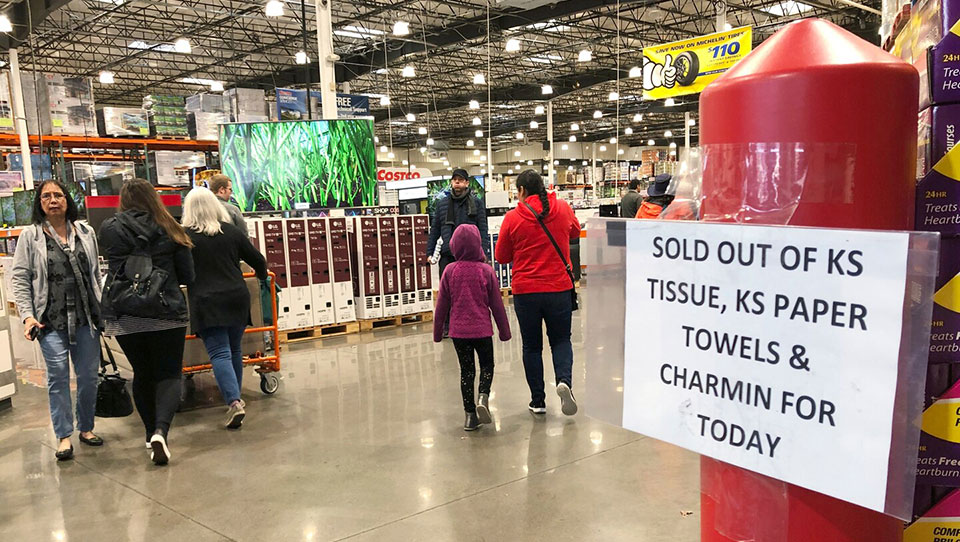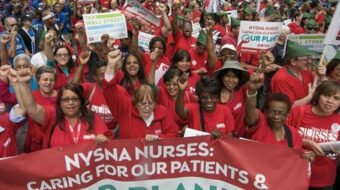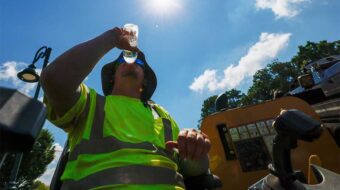
Editor’s note: The University of California at San Francisco Hospital is considered a leading health institution in the U.S. with specialization in treatment and handling of infectious disease. Like many other institutions of this type, it has put together one or more panels of experts to study the current crisis and to make proposals to the government and suggestions to the public. Unlike the press briefings prepared by the task force put together by the Trump administration, these doctors and experts do not filter their findings through a president more interested in the stock market than the health of the American people.
Peoples World prints what follows as a service to our readers and the public. The following are notes describing the main assessments of the UCSF panel when it met on March 10. They were posted online by Dr. Jordan Schlain at UCSF. The notes summarize the assessment of the official meeting on that date of the University of California, San Francisco BioHub Panel on COVID-19. While some of the findings are extremely troubling the assessments also include practical suggestions people can follow in dealing with this serious pandemic, particularly given that we have a health care system in this country which is in and of itself worthy of being declared a national emergency.
John Wojcik, editor in chief
Panelists included Joe DeRisi: UCSF’s top infectious disease researcher. He is co-president of ChanZuckerberg BioHub (a JV involving UCSF / Berkeley / Stanford) and co-inventor of the chip used in the SARS epidemic. Other members of the panel were Emily Crawford: COVID task force director whose focus is diagnostic methods, Cristina Tato, Rapid Response Director and immunologist, Patrick Ayescue, leading outbreak response and surveillance epidemiologist, and Chaz Langelier, UCSF infectious disease doctor.
What’s below are essentially direct quotes from the panelists. I bracketed the few things that are not quotes.
Top takeaways: At this point, we are past containment. Containment is basically futile. Our containment efforts won’t reduce the number who get infected in the U.S. Now we’re just trying to slow the spread, to help healthcare providers deal with the demand peak. In other words, the goal of containment is to “flatten the curve,” to lower the peak of the surge of demand that will hit healthcare providers. And to buy time, in hopes a drug can be developed.
How many in the community already have the virus? No one knows.
We are moving from containment to care.
We in the U.S. are currently where Italy was a week ago. We see nothing to say we will be substantially different.
Forty to 70% of the US population will be infected over the next 12-18 months. After that level, you can start to get herd immunity. Unlike flu, this is entirely novel to humans, so there is no latent immunity in the global population.
[We used their numbers to work out a guesstimate of deaths— indicating about 1.5 million Americans may die. The panelists did not disagree with our estimate. This compares to seasonal flu’s average of 50K Americans per year. Assume 50% of U.S. population, that’s 160M people infected. With 1% mortality rate that’s 1.6M Americans die over the next 12-18 months.
The fatality rate is in the range of 10X flu.
This assumes no drug is found effective and made available.
The death rate varies hugely by age. Over age 80 the mortality rate could be 10-15%.
Don’t know whether COVID-19 is seasonal but if it is and subsides over the summer, it is likely to roar back in fall as the 1918 flu did
I can only tell you two things definitively. Definitively it’s going to get worse before it gets better. And we’ll be dealing with this for the next year at least. Our lives are going to look different for the next year.
What should we do now? What are you doing for your family?
Appears one can be infectious before being symptomatic. We don’t know how infectious before symptomatic, but know that the highest level of virus prevalence coincides with symptoms. We currently think folks are infectious 2 days before through 14 days after onset of symptoms (T-2 to T+14 onset).
How long does the virus last?
On surfaces, best guess is 4-20 hours depending on the surface type (maybe a few days) but still no consensus on this
The virus is very susceptible to common anti-bacterial cleaning agents: bleach, hydrogen peroxide, alcohol-based.
Avoid concerts, movies, crowded places.
We have canceled business travel.
Do the basic hygiene, e.g. hand washing and avoiding touching face.
Stockpile your critical prescription medications. Many pharma supply chains run through China. Pharma companies usually hold 2-3 months of raw materials, so they may run out given the disruption in China’s manufacturing.
Pneumonia shot might be helpful. Not preventative of COVID-19, but reduces your chance of being weakened, which makes COVID-19 more dangerous.
Get a flu shot next fall. Not preventative of COVID-19, but reduces your chance of being weakened, which makes COVID-19 more dangerous.
We would say “Anyone over 60 stay at home unless it’s critical”. CDC toyed with the idea of saying anyone over 60 not travel on commercial airlines.
We at UCSF are moving our “at-risk” parents back from nursing homes, etc. to their own homes. Then are not letting them out of the house. The other members of the family are washing hands the moment they come in.
Three routes of infection: Hand to mouth/face; Aerosol transmission and Fecal oral route.
What if someone is sick?
If someone gets sick, have them stay home and socially isolate. There is very little you can do at a hospital that you couldn’t do at home. Most cases are mild. But if they are old or have lung or cardio-vascular problems, read on.
If someone gets quite sick who is old (70+) or with lung or cardio-vascular problems, take them to the ER.
There is no accepted treatment for COVID-19. The hospital will give supportive care (e.g. IV fluids, oxygen) to help you stay alive while your body fights the disease. i.e. to prevent sepsis.
If someone gets sick who is high risk (e.g. is both old and has lung/cardio-vascular problems), you can try to get them enrolled for “compassionate use” of Remdesivir, a drug that is in clinical trial at San Francisco General and UCSF, and in China. Need to find a doc there in order to ask to enroll. Remdesivir is an anti-viral from Gilead that showed effectiveness against MERS in primates and is being tried against COVID-19. If the trials succeed it might be available for next winter as production scales up far faster for drugs than for vaccines. [More I found online.]
Why is the fatality rate much higher for older adults?
Your immune system declines past age 50.
Fatality rate tracks closely with “co-morbidity”, i.e. the presence of other conditions that compromise the patient’s hearth, especially respiratory or cardiovascular illness. These conditions are higher in older adults.
Risk of pneumonia is higher in older adults.
What about testing to know if someone has COVID-19?
Bottom line, there is not enough testing capacity to be broadly useful. Here’s why.
Currently, there is no way to determine what a person has other than a PCR test. No other test can yet distinguish “COVID-19 from flu or from the other dozen respiratory bugs that are circulating”.
A Polymerase Chain Reaction (PCR) test can detect COVID-19’s RNA. However they still don’t have confidence in the test’s specificity, i.e. they don’t know the rate of false negatives.
The PCR test requires kits with reagents and requires clinical labs to process the kits.
While the kits are becoming available, the lab capacity is not growing.
The leading clinical lab firms, Quest and Labcore have capacity to process 1000 kits per day. For the nation.
Expanding processing capacity takes “time, space, and equipment.” And certification. i.e. it won’t happen soon.
UCSF and UC Berkeley have donated their research labs to process kits. But each has capacity to process only 20-40 kits per day. And are not clinically certified.
Novel test methods are on the horizon, but not here now and won’t be at any scale to be useful for the present danger.
How well is society preparing for the impact?
Local hospitals are adding capacity as we speak. UCSF’s Parnassus campus has erected “triage tents” in a parking lot. They have converted a ward to “negative pressure” which is needed to contain the virus. They are considering re-opening the shuttered Mt Zion facility.
If COVID-19 affected children then we would be seeing mass departures of families from cities. But thankfully now we know that kids are not affected.
School closures are one of the biggest societal impacts. We need to be thoughtful before we close schools, especially elementary schools because of the knock-on effects. If elementary kids are not in school then some hospital staff can’t come to work, which decreases hospital capacity at a time of surging demand for hospital services.
Public Health systems are prepared to deal with short-term outbreaks that last for weeks, like an outbreak of meningitis. They do not have the capacity to sustain for outbreaks that last for months. Other solutions will have to be found.
What will we do to handle behavior changes that can last for months?
Many employees will need to make accommodations for elderly parents and those with underlying conditions and immune-suppressed.
Kids home due to school closures
[Dr. DeRisi had to leave the meeting for a call with the governor’s office. When he returned we asked what the call covered.] The epidemiological models the state is using to track and trigger action. The state is planning at what point they will take certain actions. i.e. what will trigger an order to cease any gatherings of over 1000 people.
Where do you find reliable news?
The John Hopkins Center for Health Security site. Which posts daily updates. The site says you can sign up to receive a daily newsletter on COVID-19 by email. [I tried and the page times out due to high demand. After three more tries I was successful in registering for the newsletter.]
The New York Times is good on scientific accuracy.
Observations on China:
Unlike during SARS, China’s scientists are publishing openly and accurately on COVID-19.
While China’s early reports on incidence were clearly low, that seems to trace to their data management systems being overwhelmed, not to any bad intent.
Wuhan has 4.3 beds per thousand while U.S. has 2.8 beds per thousand. Wuhan built 2 additional hospitals in 2 weeks. Even so, most patients were sent to gymnasiums to sleep on cots.
Early on no one had info on COVID-19. So China reacted in a way unique modern history, except in wartime.
Every few years there seems another: SARS, Ebola, MERS, H1N1, COVID-19. Growing strains of antibiotic-resistant bacteria. Are we in the twilight of a century of medicine’s great triumph over infectious disease?
“We’ve been in a back and forth battle against viruses for a million years.”
But it would sure help if every country would shut down their wet markets.
As with many things, the worst impact of COVID-19 will likely be in the countries with the least resources, e.g. Africa. See article on Wired magazine on the sequencing of the virus from Cambodia.












Comments